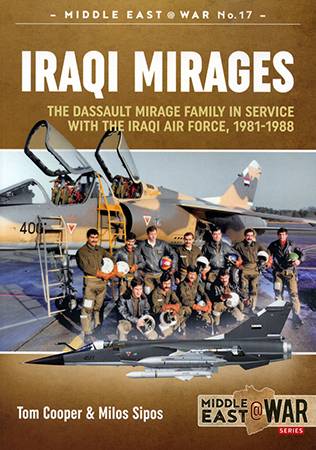
Iraqi Mirages: Mirage F.1 in Service with Iraqi Air Force, 1981-1988 Book Review
By David L. Veres
| Date of Review | May 2019 | Title | Iraqi Mirages: Mirage F.1 in Service with Iraqi Air Force, 1981-1988 |
|---|---|---|---|
| Author | Tom Cooper, Milos Sipos | Publisher | Helion |
| Published | 2019 | ISBN | 9781912390595 |
| Format | 96 pages, softbound | MSRP (GBP) | £16.95 |
Review
Mirage F.1s in Iraqi use proved highly capable, multi-role platforms in combat.
Now Tom Cooper and Milos Sipos tell the terrific tale in Iraqi Mirages: Mirage F.1 in Service with Iraqi Air Force, 1981-1988 – 17th in Helion’s intensely informative “Middle East@War” range.
Contents commence with notes on the historical background and pre-war Franco-Iraqi technical and infrastructure cooperation.
Coverage quickly segues to Iraq’s eight-year war with Iran. And commentary chronologically charts actions associated with the French warplane.
Despite “an almost complete collapse of order and discipline” after the 1979 Revolution, the Islamic Republic of Iran Air Force (IRIAF) offered “fanatical resistance” to its historical foe.
“Within just two weeks,” authors note, “the main prongs of the Iraqi advance were stopped by severe casualties”. Worse, the IRIAF quickly began “ranging wide and far over Iraq to bomb whatever it wanted to bomb”.
Mirage F.1 deliveries and French assistance helped modestly to stabilize Iraqi reversals. And Iraqi F.1s successfully conducted a variety of missions during war with Iran.
Anti-radar. Reconnaissance. Strike. And interception – including destructions of fearsome F-14A Tomcats. Authors deftly recap associated actions and background developments.
Nor does text exclusively examine Iraqi Mirage F.1s. Authors also relate operations of Aérospatiale AM.39 Exocet-equipped, “rented” Super Etendard maritime strike aircraft and, in the world’s first combat use of the notorious weapons, Super Frelon helicopters.
Even more remarkably, Iraq converted one of five Falcon 50 business jets for Exocet missions. Code-named Suzanna, this aircraft infamously scored hits on the USS Stark, 17 May 1987.
Cooper and Sipos recap more than just aircraft and airmen, operations and ordinance. Text tackles topics as diverse as Iraq’s “institutionalized” command problems, equipment procurement and integration issues, targeting decisions, and specious victory claims.
Photos, maps, diagrams, drawings, tables, and sidebars augment the account. And abbreviations, references, and endnotes further supplement the study.
Fifteen Mirage F.1 profiles with color notes and external loads also provide potent project appeal. A single plan view helpfully depicts standard F.1 dorsal camouflage. And three final plates illustrate a Super Etendard, Falcon 50, and Mirage 2000IQ.
Authors offer, in short, concise, multi-dimensional commentary on the total topic. That’s the hallmark of Helion’s outstanding “@War” approach. And it certainly defines this excellent effort.
But to claim that Iraq “was not working on the development of a nuclear weapon as of 1981” frankly beggars belief!
With thanks to Helion for the review copy!







